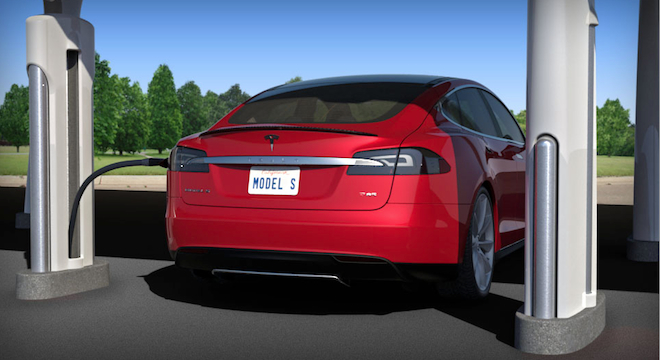Tesla Motors, the high-performance electric car company founded by modern day industrialist Elon Musk (also the CEO of commercial spacefaring company SpaceX), is supercharging its new cars: The company on Monday night unveiled a new fleet of supercharging stations for its upcoming Model S sedans, starting with six stations spaced throughout California, where the company is headquartered.
Musk introduced the new “Supercharger” technology at the Tesla Motors HQ in Hawthorne, California on Monday, saying that the Supercharger his company designed was the “answer to the three major problems that are holding back electrical vehicles, or at least that people think are holding back electric vehicles.”
Specifically, Musk said that the Supercharger would address the issue of “range anxiety” (that electric vehicles have more limited range than their gasoline and petroleum-powered counterparts), the problem of passing greenhouse gas emissions off to the source of the electrical charge, the power plants (an issue known as “upstream emissions“), and the higher upfront costs of electric vehicles over gasoline-powered cars.
Check out video of the Tesla Motors Supercharger unveiling event below:
The new Tesla Motors Superchargers eliminate recharge costs entirely: They’re free to use for Tesla Model S owners.
Tesla hasn’t actually shipped any of what it says will be a pioneering electric vehicle that’s fun to drive, but has nearly 13,000 pre-orders and aimed to deliver 5,000 cars to their owners by the end of the year, as the Wall Street Journalreported.
As for the emissions problem, Tesla Motors and Musk claim that the Superchargers actually result in negative emissions because they rely on a solar “carport system” developed by Musk’s other company, SolarCity. The solar system produces more electricity than over the period of one year than is used by the Model S vehicles, and that excess power is returned to the electrical grid.
As for the long distance travel requirement: Tesla Motors also emphasized the relative speed and convenience of its Supercharger stations, comparing them to stopping for lunch in the middle of a day-long road trip.
The Superchargers can “replenish three hours of driving at 60 mph in about half an hour,” according to a Tesla Motors press release. A Model S with a 85 kilowatt-hour battery can get 150 miles on one of these 30-min “half” charges, or about half of its total range per full charge.
Each provides 100 kilowatts of power to a Model S car, but Tesla Motors said it had the capacity to expand to 120 kilowatts in the near future, meaning even faster charging and longer range per charge.
So far, Tesla Motors has installed six Supercharging stations stretching across central and Southern California. The company released the following map showing where they are located around the state:

However, Tesla Motors’ exciting announcement was quickly tempered by bad financial and production news from the company: In regulatory filings submitted Monday to the Securities and Exchange Commission, Tesla Motors declared it is four or five weeks behind its Model S production schedule, is cutting its annual revenue projections by $160 million (from an original $560 million to $600 million), and will delay repayment on a $465 million Energy Department loan, and is going to dilute its shares by releasing another 4.34 million, as The Wall Street Journal and MarketWatch reported.
Tesla Motors has already delivered 2,350 vehicles in its first line of cars, the Tesla Roadster, to owners around the globe. It plans to expand its Supercharger stations for the new Model S vehicles “in high traffic corridors across the continental United States, enabling fast, purely electric travel from Vancouver to San Diego, Miami to Montreal and Los Angeles to New York.”






